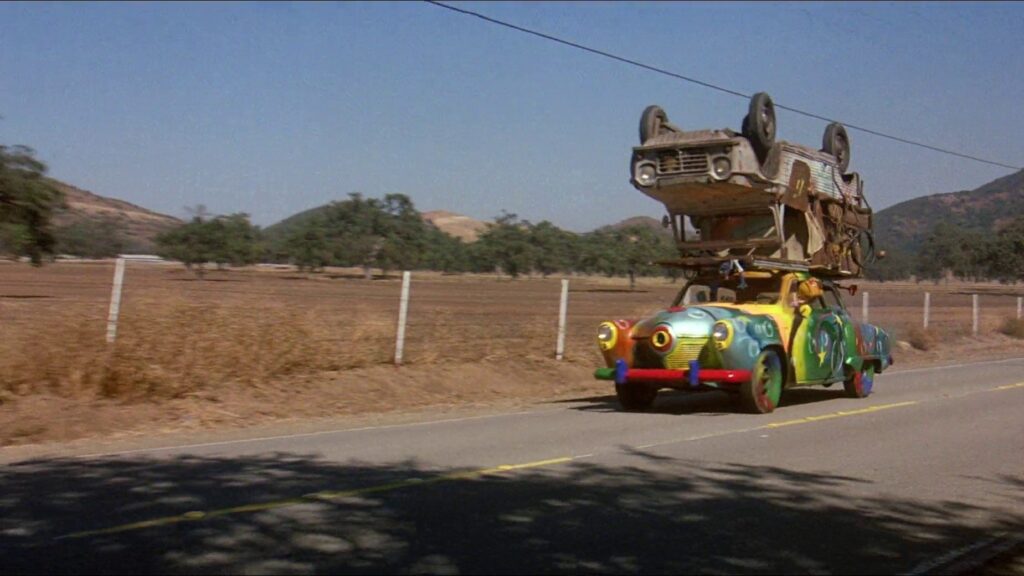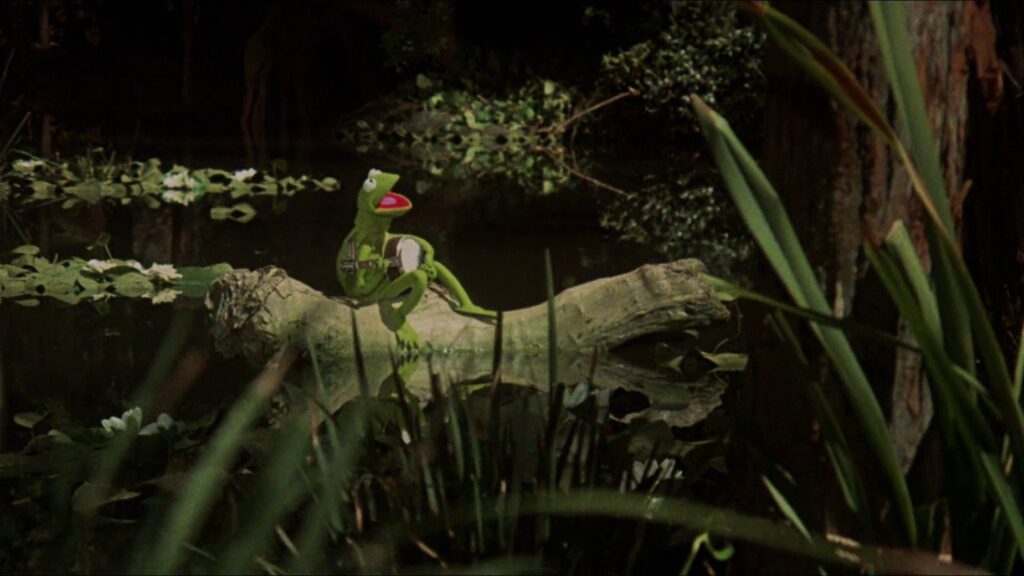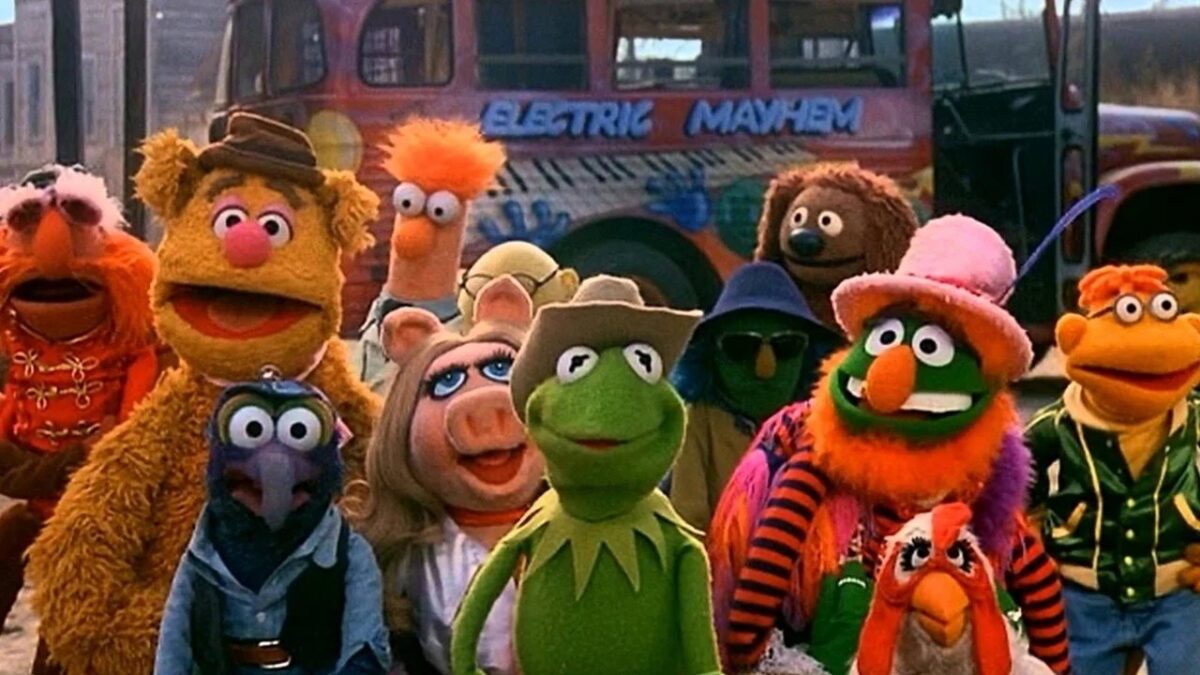All of us under its spell
The Muppet Show was a show about Muppets making a show called The Muppet Show. But when you hit the silver screen, you gotta go big or go home, and so Jim Henson and co. amped up the meta layers: The Muppet Movie is a movie about Muppets watching The Muppet Movie, a movie about Muppets who want to be in the movies, and the movie the Muppets end up making is a Muppet movie retelling The Muppet Movie’s The Muppet Movie. The story’s progress hinges multiple times upon characters learning the past or future by reading the screenplay for the movie (not for our Muppet Movie, but the Muppets’ movie The Muppet Movie, though I guess that is The Muppet Movie).
This is an origin story: how Kermit the Frog (Jim Henson) leaves the swamp with a banjo and a dream, meets Fozzie Bear (Frank Oz), Gonzo (Dave Goelz), and Miss Piggy (Oz), dodges the cruel but high-paying temptations of Doc Hopper (Charles Durning) and his long-suffering henchman Max (Austin Pendleton), and caravans to Hollywood. But the film isn’t in a hurry to arrive anywhere. For a puppet troupe famous for anarchy, their film’s pacing is episodic and almost methodical. Scenes and songs have room to breathe, to the point where a few stretches dilly-dally. Yet it all feels carefully controlled and handmade, a truly enchanting film.
This is no surprise to anyone familiar with Henson’s work. The beloved creator had a knack for making projects hold together, filled with wit and introspection that was never navel-gazing or noodling. Though his puppets and stories exhibited infinite imagination, he never lost his human touch, even (and especially) when no humans appeared on screen. Many of Henson’s shows and movies, the Muppets in particular, are about the act of creation: the industry, impulses, and mechanisms for telling stories for the screen, and The Muppet Movie falls in that tradition. The entire story and many of the specific episodes are parodies of Hollywood tropes or else reflections on creating art, the tone ranging from slapstick to sitcom to sincere.

The one-by-one intro of each Muppet across the runtime means that every character gets a mini-showcase for their specific comic mode: Kermit’s dry by gentle sarcasm, Piggy’s diva flamboyance, Fozzie’s flop sweat optimism, Gonzo’s surreal sincerity. Even Hopper’s aggressive capitalism is a winning blend of silly and sinister, his frog-leg stands and greed for bigger profits the perfect stuff of children’s-movie villainy: funny to watch, dead serious about ruining something beautiful.
Perhaps the movie’s MVP (which is saying something) is Paul Williams, who pens a remarkable soundtrack. “Rainbow Connection” is one of the rare songs that becomes a instant standard the instant you hear it, as if it had existed forever and the movie just happened to be its point of emergence, like “White Christmas” in Holiday Inn or “Cruisin’ For a Bruisin” in Teen Beach Movie. The image of a swamp frog plucking the banjo and singing his own spin on “Somewhere Over the Rainbow” — in natural Muppet meta form, an ode to the existence of so many great rainbow songs, including itself — is indelible. “Movin’ Right Along” is pure road-movie giddiness, and “I’m Going to Go Back There Someday” is nearly equal to “Rainbow Connection”: melancholy, searching, almost too piercing for a film full of wacky puppets. Goelz sang it at Henson’s funeral. The songs don’t comment on the narrative so much as define its spiritual weather: wonder, hope, the ache of not-quite-yet. Williams’ music elevates the Muppets to a higher plane; with his compositions, the ragtag bag of rags captures humanity’s capacity to make something beautiful together, something greater than our sum.

Visually, The Muppet Movie is delightful, too. The on-location puppetry is always sensational: wide shots you can’t cheat, full-body Kermit bits that must have taken hours to execute perfectly, etc. The movie beautifully captures the American heartland as seen driving down the Interstate: sunlit frames, dusty diners, a road that curves to the horizon. The filmmaking team almost never takes the easy way out, building a huge variety of sets and production details. Director James Frawley keeps the rhythm and compositions clean and the camera adventurous. You can always sense Henson’s guiding hand: a belief that the performances — felt or flesh — are always more important than all of the puppetry muscle-flexing and visual gags.
The human cameos are plenty of fun: Steve Martin, Madeline Kahn, B.A.D.S. winner Carol Kane (“Myth! Myth!”), Mel Brooks, and, in a perfect closing grace note, Orson Welles. None of them hijack the movie (though Brooks, the campiest here, threatens to); instead, they slip into the Muppet rhythm, sharp and funny but well-integrated into the film.
By the end, the myth of the Muppets is fully realized: a found family, rolling west, excited to share their talent and joy with the world. The jokes sparkle, the songs glow, the pace ambles, and it all coheres into a statement that defines Henson’s legacy: entertainment as a form of connecting, of reaching for higher truths, of making the world a little bit lighter. For loving, for dreaming, for us.
Is It Good?
Exceptionally Good (7/8)
Dan is the founder and head critic of The Goods. Follow Dan on Letterboxd. Join the Discord for updates and discussion.


4 replies on “The Muppet Movie (1979)”
Lovely film, ain’t it?
I will cosign on Brooks. His bit is kind of actually bad.
This is what happens when you won’t let a man blow up some Illinois Nazis (Literally or metaphorically): why should THE BLUES BROTHERS get all the fun?
I somehow never saw it all the way through until I showed it to my kids this week! Really holds up.
I suspect that good musicals tend to, because they’re inherently detached from reality in a way that allows one to take a great deal of weirdness in stride.